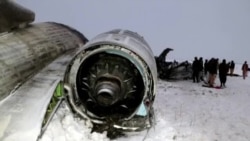After a U.S. military plane crashed in Taliban-controlled territory in Afghanistan on Jan. 27, several Russia and Iran-linked web sites claimed the Taliban had shot down the plane.
A YouTube video describes the E11-A communications plane.
These sites also claimed that the CIA official in charge of the U.S. operation that killed Qassem Soleimani, commander of the elite Quds Force of Iran’s Revolutionary Guard Corps (IRGC), died in the crash. They reported the CIA officer’s body was taken by the militants, along with a stash of top secret CIA documents. They identified the “dead” official as “Mike de Andrea,” misspelling the name of Michael D’Andrea, chief of the CIA’s Iran Mission Center.
One of the sites, VeteransToday.com, wrote: “It has been reported that Mike de Andrea [sic] responsible for the assassination of the martyr Major General Qassem Soleimani was killed in the accident of the American plane that was shot down in Afghanistan. He is the most prominent figure of the CIA intelligence in the region.”
While Iranian media cited sources in the Taliban in their stories about the incident, VeteransToday.com said its report about D’Andrea’s death in Afghanistan was “original” and confirmed by “Russian intelligence sources.”
This version of events surrounding the crash gradually made its way to the British newspapers the Daily Mail and The Independent, but other media, including Time magazine, called it “disinformation.”
Indeed, it is likely false.
The Crash
Afghan, NATO and U.S. officials said the plane, identified as a U.S. Air Force Bombardier E-11A electronic surveillance aircraft, was not shot down, but crashed.
Several media reports citing interviews with witnesses support that scenario.
Radio Free Europe/Radio Liberty reported that residents near where the aircraft crashed in Afghanistan’s Ghazni Province said they did not believe claims that militants had shot down the plane. One witness told RFE/RL he watched a plane “rotating in the air as it fell down.”
A witness told Al Jazeera that the plane was heading from the location of Gazhni city “towards this place” and suddenly “began flying a little lower” for no apparent reason, after which it “crash-landed.”
None of the witnesses mentioned seeing or hearing blasts while the plane was aloft. Likewise, there were no reports that the plane was on fire before it crashed.
The Pentagon said the incident remains under investigation but there were no indications the plane crashed as a result a “hostile action.” It said “only two people” were aboard, both of whom died.
A local journalist told the Associated Press he saw “two bodies” near the “badly burned” plane.
On Jan. 27, a U.S. defense official said the bodies of the two American service members were recovered. The bodies were "treated with dignity and respect by the local Afghan community, in accordance with their culture," the Pentagon said.
A U.S recovery team “met no Taliban resistance in reaching the site,” the official said, adding that there were “no indications the plane was downed by a hostile action.” The recovery team “secured” the flight data recorder and destroyed the remaining wreckage.
On Jan. 28, the U.S. Defense Department identified the two officers killed in the E-11A crash as Lt. Col. Paul K. Voss, 46, and Capt. Ryan S. Phaneuf, 30.
Asked about reports of D’Andrea’s “death” in the crash, the U.S. Defense Department told Polygraph.info: “There were only two people on the E-11A aircraft that crashed in Afghanistan on January 27. They were the two U.S. Air Force officers identified by the Defense Department on January 29."
Why Michael D’Andrea?
Business Insider reported on Jan. 28 that Iranian state TV “spread a wild theory” claiming that a senior CIA official killed in the E-11A crash had been behind the killing of Soleimani. Multiple Iranian and Russian media outlets picked up the story.
There was a red flag in the Iranian reports.
To identify D’Andrea, Iran’s state TV used a screenshot from the Hollywood movie “Zero Dark Thirty,” about the U.S. operation to kill Osama bin Laden in May 2012. The screenshot was a photo of Frederic Lehne, the actor who played “The Wolf,” a top CIA official in the film whose character was reportedly based on D’Andrea.
In 2012, the Washington Post published a profile of the chief of the CIA’s Counter terrorism Center, identifying him only by his code name “Rodger.”
Three years later, in April 2015, the New York Times identified him as Michael D’Andrea.
According to more recent reports, D’Andrea was appointed head of the CIA’s Iran desk in 2017 by the agency’s then director, Mike Pompeo. There has been no confirmation that D’Andrea oversaw or was involved in the operation that killed Soleimani.
Former CIA Officers Dispute the Scenario
Analysts have disputed the claim that D’Andrea died in the E-11A crash.
“This is pure propaganda,” John Sipher, a former senior official in the CIA’s National Clandestine Service, told Polygraph.info. “Obviously, I do not know for certain, but I would bet my home that it is totally false.”
Sipher, who runs Spycraft Entertainment, a firm consulting movie directors and authors, added: “Unlike in the movies, senior CIA officers do not rush into the field to handle issues. Nor do they often fly in military planes.”
One of the few articles to question the U.S. official account of crash was written by Philip Giraldi, a former CIA counter-terrorism specialist, and published in the American Herald Tribune.
Giraldi’s analysis, however, contains information that’s been challenged, including the claims that hostile fire prevented the U.S. recovery team from getting to the crash site and that the Pentagon never revealed how many people were aboard.
Media Metrics website, which rates news organization bias, described the American Herald Tribune as a “conservative-pseudoscience” website; a CNN investigation suggested the site “originates in Iran.”
The CIA did not respond to Polygraph.info inquiry about D’Andrea.






